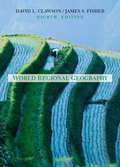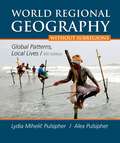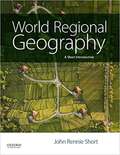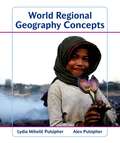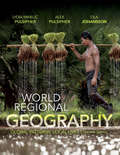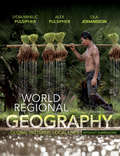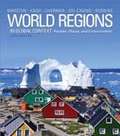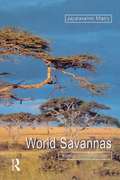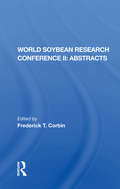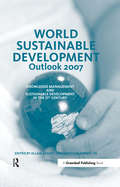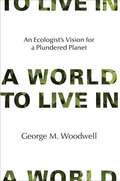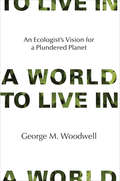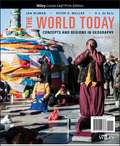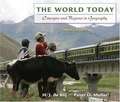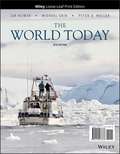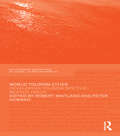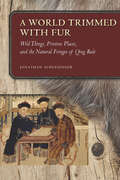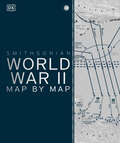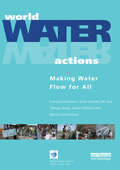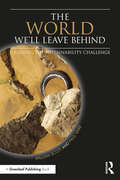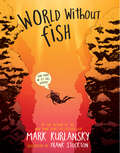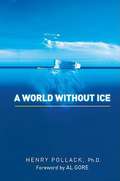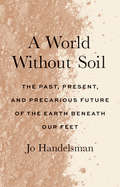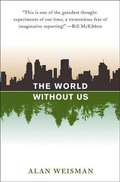- Table View
- List View
World Regional Geography: A Development Approach (8th edition)
by David L. Clawson Merrill L. JohnsonThis book is organized around the central theme of human development. Each author employs the human development theme to create a substantive volume on world regional geography that presents a vital, issues-oriented overview of the topic.
World Regional Geography: Global Patterns, Local Lives (Without Subregions) (Sixth Edition)
by Lydia Mihelic Pulsipher Alex A. Pulsipher Conrad Mac" GoodwinThe main goal of this book is to make global patterns of trade and consumption meaningful for students by showing how these patterns affect not only world regions but also ordinary people at the local level.
World Regional Geography: A Short Introduction
by John Rennie ShortWorld Regional Geography: A Short Introduction is a compact, focused, and affordable book that provides foundational materials with an emphasis on contemporary issues. The crisp text introduces students to the character of world regional geography--the distinctiveness of different parts of the world--but also the linkages and connections. Part One sets the scene: one introductory chapter discusses the opportunities and dangers in using maps, data, and different scales of analysis, while another surveys broad global trends. The second part of the book explores these trends in sharper focus in a concise geography of the major regions of the world: Central America and the Caribbean, South America, Europe, Russia and its neighbors, East Asia, South East Asia, South Asia, Middle East and North Africa, Sub-Saharan Africa, Australia and Oceania, and North America. Each chapter examines a region's environmental context, historical geography, economic transformation, urban and rural trends, social geography and geopolitics. Three features distinguish each regional chapter: · Focus spotlights a unique area within each region · Connections highlights a regional attribute that connects it to other regions · Subregions illustrates the diversity within each region This full-color text--featuring meticulously-crafted original maps--is ideal for instructors who prefer the versatility of a concise book with the advantage of a compelling text.
World Regional Geography Concepts
by Lydia Mihelic Pulsipher Alex A. PulsipherThe authors of World Regional Geography have answered the need for an exceptionally brief textbook for the evolving world regional course. In World Regional Geography Concepts, eight major thematic concepts frame the coverage and give students a way of approach the wealth of information in the text. Like the Pulsiphers' longer text, World Regional Geography Concepts emphasizes global trends and the interregional linkages that are changing lives throughout the world, humanizes geographical issues by representing the lives of women, men, and children in various regions of the globe.
World Regional Geography, Seventh Edition
by Lydia Mihelič Pulsipher Alex Pulsipher Ola JohanssonPulsipher's World Regional Geography, Seventh Edition, without Subregions shows the rich diversity of human life and demystifies global issues by representing the daily lives of men, women, and children in the various regions of our globe. The seventh edition uses a new thematic framework to organize information and help students think critically about the local and global impacts of environment; gender and population; urbanization; globalization and development; and power and politics. This edition is also available in a version that includes coverage of subregions (978-1-319-04804-4).
World Regional Geography (Without Subregions), Seventh Edition
by Lydia Mihelič Pulsipher Alex Pulsipher Ola JohanssonPulsipher's World Regional Geography, Seventh Edition, without Subregions shows the rich diversity of human life and demystifies global issues by representing the daily lives of men, women, and children in the various regions of our globe. The seventh edition uses a new thematic framework to organize information and help students think critically about the local and global impacts of environment; gender and population; urbanization; globalization and development; and power and politics. This edition is also available in a version that includes coverage of subregions (978-1-319-04804-4).
World Regions in Global Context: Peoples, Places, and Environments (5th Edition)
by Sallie A. Marston Paul L. Knox Diana M. Liverman Vincent J. Del Casino Paul F. RobbinsThe author provides a framework for understanding the global connections that affect the dynamic and complex relationships between people and the worlds they inhabit.
World Savannas: Ecology and Human Use
by Jayalaxshm Mistry Andrea BeradiAn interdisciplinary text on the world's savannas, covering the geography, ecology, economics and politics of savanna regions. Savannas are a distinct vegetation type, covering a third of the world's land surface area and supporting a fifth of the world's population. There has been a wide range of literature on the subject, but the majority of work has focused on the ecology or development of savanna areas, ignoring the wider interdisciplinary issues affecting contemporary savannas. World Savannas aims to buck this trend, providing students with an up-to-date and comprehensive introduction to the global importance of savannas.
World Soybean Research Conference Ii, Abstracts
by Frederick T CorbinThe result of strong international interest in the soybean, the World Soybean Research Conference II was held March 26-29, 1979, at North Carolina State University. This volume contains summaries of the more than two hundred papers presented at that meeting. The authors, international authorities in their fields, represent sixteen areas of professi
World Sustainable Development Outlook 2007: Knowledge Management and Sustainable Development in the 21st Century (World Sustainable Development Outlook Ser.)
by Allam AhmedThe World Sustainable Development Outlook series has been developed to provide an overview of sustainable development, to discuss why it is important and to provoke forward thinking on the development of a more coherent approach to solving global problems related to sustainability through science and technology. In doing so, a holistic approach is used to critically examine the interrelationship between the natural, governmental, economic and social dimensions of our world and how science and technology can contribute to solutions. This is a truly global source book, which is reflected in the varied national and cultural origins of the contributors, as well as the topics and case studies covered. Each year a different theme will be covered. The theme of World Sustainable Development Outlook 2007 is the different dimensions of knowledge and technology management in the new era of information revolution and how they relate to sustainable development. Rapid innovation in information and communication technologies (ICTs) is clearly reshaping the world we live in. Countries are increasingly judged by whether they are information-rich or information-poor. It is estimated that 30–40% of the world's economic growth and 40–50% of all new jobs will be IT-driven. Education and knowledge are the chief currencies of the modern age, and can also be a strategic resource and a lifeline for sustainable development. Yet, in Africa, millions of people have never made a telephone call. The technological gulf between developed and developing countries (DCs) is likely to widen further with the rapid expansion of the internet and the speedy transition to digitalisation in the West. The impacts on DCs may include an increase in the so-called brain drain and growing dependence on foreign aid of a different kind – knowledge aid. There are fears that knowledge imperialism is already with us. What is clear is that most of the technological innovations in ICTs are Western-designed and fail to address the needs of the most disadvantaged. The interest of industrialised countries in the use of ICTs in DCs has largely been more concerned with the profitability of their own business enterprises than with any broader goals concerning the development of the host countries. DCs face the challenge of either becoming an integral part of the knowledge-based global economy or the very real danger of finding themselves on the wrong side of the digital divide. Successful management in the new millennium requires developing new methods and approaches to meet the challenges and opportunities of this information revolution while at the same time fostering sustainable development. Adopting a holistic approach, this book aims to critically examine the interrelationship between these different issues in order to reach solutions and a consensus for a better future, taking into account a variety of international, institutional and intellectual perspectives. It uses case and country studies in technological innovation and experience so that lessons in effective management of ICTs can be learned from successful initiatives, ideas and innovations.
A World to Live In
by George M. WoodwellA century of industrial development is the briefest of moments in the half billion years of the earth's evolution. And yet our current era has brought greater changes to the earth than any period in human history. The biosphere, the globe's life-giving envelope of air and climate, has been changed irreparably. In A World to Live In, the distinguished ecologist George Woodwell shows that the biosphere is now a global human protectorate and that its integrity of structure and function are tied closely to the human future. The earth is a living system, Woodwell explains, and its stability is threatened by human disruption. Industry dumps its waste globally and makes a profit from it, invading the global commons; corporate interests overpower weak or nonexistent governmental protection to plunder the planet. The fossil fuels industry offers the most dramatic example of environmental destruction, disseminating the heat-trapping gases that are now warming the earth and changing the climate forever. The assumption that we can continue to use fossil fuels and "adapt" to climate disruption, Woodwell argues, is a ticket to catastrophe.But Woodwell points the way toward a solution. We must respect the full range of life on earth -- not species alone, but their natural communities of plant and animal life that have built, and still maintain, the biosphere. We must recognize that the earth's living systems are our heritage and that the preservation of the integrity of a finite biosphere is a necessity and an inviolable human right.
A World to Live In: An Ecologist's Vision for a Plundered Planet
by George M. WoodwellA scientist makes a powerful case that preservation of the integrity of the biosphere is a necessity and an inviolable human right.A century of industrial development is the briefest of moments in the half billion years of the earth's evolution. And yet our current era has brought greater changes to the earth than any period in human history. The biosphere, the globe's life-giving envelope of air and climate, has been changed irreparably. In A World to Live In, the distinguished ecologist George Woodwell shows that the biosphere is now a global human protectorate and that its integrity of structure and function are tied closely to the human future. The earth is a living system, Woodwell explains, and its stability is threatened by human disruption. Industry dumps its waste globally and makes a profit from it, invading the global commons; corporate interests overpower weak or nonexistent governmental protection to plunder the planet. The fossil fuels industry offers the most dramatic example of environmental destruction, disseminating the heat-trapping gases that are now warming the earth and changing the climate forever. The assumption that we can continue to use fossil fuels and “adapt” to climate disruption, Woodwell argues, is a ticket to catastrophe.But Woodwell points the way toward a solution. We must respect the full range of life on earth—not species alone, but their natural communities of plant and animal life that have built, and still maintain, the biosphere. We must recognize that the earth's living systems are our heritage and that the preservation of the integrity of a finite biosphere is a necessity and an inviolable human right.
The World Today: Concepts And Regions In Geography
by Peter O. Muller Jan Nijman Harm J. de BlijThe World Today, Binder Ready Version, 7th Edition is the number one bestselling brief World Regional Geography textbook. The seventh edition continues to bring readers geographic perspectives on a fast-changing world through the regional view. Restructured chapters provide a macro review of important physical, cultural, and political characteristics, drawing upon up-to-date significant world events and crises. The cartographically superior maps have been updated for the seventh edition to offer an accurate and vast picture of the world--multi-layer, interactive, GIA maps have been added to WileyPLUS Learning Space. To complement the extensive map program, the majority of the photos have been taken by our authors during their field research, allowing the student to experience an authentic geographical viewpoint of our world.
The World Today: Concepts and Regions in Geography
by Peter O. Muller Eugene Joseph Palka H. J. de BlijTextbook on the geography of the world toward the close of the first decade of the twenty-first century as well as a guide to geographic ideas and perspectives, past and present.
The World Today: Concepts and Regions in Geography
by Jan Nijman Peter O. Muller Michael ShinIn the 8th edition of this market-leading title, The World Today continues to break new ground in the interpretation and teaching of world regional geography. The text explains the contemporary world’s geographic realms in terms of their natural environments and human dimensions in a clear and concise fashion. The authors look at the ways people have organized their living space, adapted to changing social as well as environmental circumstances, and continue to confront forces largely beyond their control ranging from globalization to climate change. <p> This book offers an approach to Geography that meshes theoretical concepts with regional realities. The evolving regional content of the chapters in the 8th edition of The World Today reflects the dynamic nature of the world’s geography; the changing and growing number of concepts mirror the progress of the discipline; and the ongoing introduction of new digital features reflects the instructional possibilities of new technologies.
World Tourism Cities: Developing Tourism Off the Beaten Track (Contemporary Geographies of Leisure, Tourism and Mobility)
by Peter Newman Robert MaitlandThis book presents new research on the capacity of big cities to generate new tourism areas as visitors discover and help create new urban experiences off the beaten track. It examines similarities and differences in these processes in a group of established world cities located in the global circuits of tourism. The cities featured are Berlin, New York, London, Paris, and Sydney. In these cities experienced city visitors are contributing to the ‘discovery’ of new places to visit. Many neighbourhoods close to the historic centre and to traditional attractions offer the mix of cultural difference and consumption opportunities that can create new experiences for distinctive groups of city users. Each of the cities included in the book offers rich experiences of the re-imagining and re-branding of neighbourhoods off the beaten track, and informative stories of the complex relationships between visitors, residents and others and of the ambitions of public policy to reproduce these new tourism experiences in other parts of the city. World Tourism Cities brings together current research in each of the cities and relates the often separate field of tourism research to some of the mainstream themes of debate in urban studies addressing topics such as consumption, markets and spaces. Drawing on original research in this important group of cities this book has significant messages for public policy. In addition the book engages directly with a range of important current academic debates – about world cities, about cities as sites of consumption and about the smaller scales at which urban neighbourhoods are being transformed. The range of cities and the messages about the making of attractive places provides a timely resource for those focused in this area and the book will also have an appeal among those experienced and sophisticated city users that it focuses on.
A World Trimmed with Fur: Wild Things, Pristine Places, and the Natural Fringes of Qing Rule
by Jonathan SchlesingerIn the eighteenth and nineteenth centuries, booming demand for natural resources transformed China and its frontiers. Historians of China have described this process in stark terms: pristine borderlands became breadbaskets. Yet Manchu and Mongolian archives reveal a different story. Well before homesteaders arrived, wild objects from the far north became part of elite fashion, and unprecedented consumption had exhausted the region's most precious resources. In A World Trimmed with Fur, Jonathan Schlesinger uses these diverse archives to reveal how Qing rule witnessed not the destruction of unspoiled environments, but their invention. Qing frontiers were never pristine in the nineteenth century—pearlers had stripped riverbeds of mussels, mushroom pickers had uprooted the steppe, and fur-bearing animals had disappeared from the forest. In response, the court turned to "purification;" it registered and arrested poachers, reformed territorial rule, and redefined the boundary between the pristine and the corrupted. Schlesinger's resulting analysis provides a framework for rethinking the global invention of nature.
World War II Map by Map (DK History Map by Map)
by DKExplore World War II in unprecedented detail with this compelling geographical guide. If you're interested in finding out more about one of the deadliest wars in history, then this war book is perfect for you. World War II Map by Map is an intricately detailed history book, that will encourage you to get a sense of the magnitude, mobility and speed at which the colossal armies swept through these vast landscapes during a war that claimed millions of lives and spanned through many areas globally. Follow the key developments of World War II in unprecedented visual detail, with more than 100 specially created historical maps covering all major theatres of war. Discover how the conflict raged around the globe on land, air, and sea, while timelines provide an in-depth chronology of events. Beautiful archival photographs, contemporary artefacts, and profiles of famous leaders reveal the full story of the war that shaped the modern world. So what are you waiting for? Journey back in time and uncover: - 9 main contemporary maps, including battle maps from both Allies and Axis countries, explain key events. - Easy-to-read text panels to accompany the maps for a deeper understanding of each topic. - Set out into 5 Chapters with 11 narrative overviews- 30 photo feature spreads exploring topics beyond the War- Produced in association with the Smithsonian Institution. Bursting with striking illustrations and full of fascinating detail, this world war 2 book is the ultimate gift for history students, general readers, and military history enthusiasts. Whether you enjoy watching military documents, or you&’re looking for the perfect gift for the history lover in your life, World War II Map by Map can be enjoyed by adults and children aged 12+ alike. Written by a team of historians headed by Richard Overy as a consultant, this history book for adults examines in detail how the most destructive conflict in history changed the face of our world. At DK, we believe in the power of discovery.So why stop there? The Map by Map series includes other titles such as History of the World Map by Map and Battles Map by Map, each detailing historical events and placing them in the context of geography. DK's luxurious Map by Map books are fantastic history gifts, packed with fascinating facts, high-quality photography, and detailed profiles and descriptions of people and events.
World Water Actions: Making Water Flow for All
by Francois GuerquinThis text is divided into three parts. Part I focuses on the need for management to assess the challenges of water scarcity and plan changes based on proper valuation and financial instruments, international co-operation and efficient use. Part II analyses the problems of water scarcity and the available solutions in each main sector: water supply and sanitation, energy, health, agriculture, ecosystems and biodiversity. Part III assesses the state of the debate following the third World Water Forum and sets out the priorities for action, including increased investment, institutional reform and capacity building in the water sector. Downloadable resources with extensive case studies and statistical data accompanies this text.
The World We'll Leave Behind: Grasping the Sustainability Challenge
by William Scott Paul VareIt is now clear that human activity has influenced how the biosphere supports life on Earth, and given rise to a set of connected environmental and social problems. In response to the challenge that these problems present, a series of international conferences and summits led to discussions of sustainable development and the core dilemma of our time: How can we all live well, now and in the future, without compromising the ability of the planet to enable us all to live well? This book identifies the main issues and challenges we now face; it explains the ideas that underpin them and their interconnection, and discusses a range of strategies through which they might be addressed and possibly resolved. These cover things that governments might do, what businesses and large organisations can contribute, and the scope for individuals, families and communities to get involved. This book is for everyone who cares about such challenges, and wants to know more about them.
World Without Fish
by Frank Stockton Mark Kurlansky"Can you imagine a world without fish? It's not as crazy as it sounds. But if we keep doing things the way we've been doing things, fish could become extinct within fifty years. So let's change the way we do things!" Announcing the paperback edition of World Without Fish, the uniquely illustrated narrative nonfiction account—for kids—of what is happening to the world’s oceans and what they can do about it. Written by Mark Kurlansky, the bestselling author of Cod, Salt, The Big Oyster, and many other books, World Without Fish has been praised as “urgent” (Publishers Weekly) and “a wonderfully fast-paced and engaging primer on the key questions surrounding fish and the sea” (Paul Greenberg, author of Four Fish).?It has also been included in the New York State Expeditionary Learning English Language Arts Curriculum. Written by a master storyteller, World Without Fish connects all the dots—biology, economics, evolution, politics, climate, history, culture, food, and nutrition—in a way that kids can really understand. It describes how the fish we most commonly eat, including tuna, salmon, cod, swordfish—even anchovies— could disappear within fifty years, and the domino effect it would have: the oceans teeming with jellyfish and turning pinkish orange from algal blooms, the seabirds disappearing, then reptiles, then mammals. It describes the back-and-forth dynamic of fishermen, who are the original environmentalists, and scientists, who not that long ago considered fish an endless resource. It explains why fish farming is not the answer—and why sustainable fishing is, and how to help return the oceans to their natural ecological balance. Interwoven with the book is a twelve-page full-color graphic novel. Each beautifully illustrated chapter opener links to the next to form a larger fictional story that perfectly complements the text.
A World Without Ice
by Henry PollackA cowinner of the 2007 Nobel Peace Prize offers a clear-eyed explanation of the planet's imperiled ice. Much has been written about global warming, but the crucial relationship between people and ice has received little focus-until now. As one of the world's leading experts on climate change, Henry Pollack provides an accessible, comprehensive survey of ice as a force of nature and the potential consequences as we face the possibility of a world without ice. A World Without Ice traces the effect of mountain glaciers on supplies of drinking water and agricultural irrigation, as well as the current results of melting permafrost and shrinking Arctic sea ice-a situation that has degraded the habitat of numerous animals and sparked an international race for seabed oil and minerals. Catastrophic possibilities loom, including rising sea levels and subsequent flooding of low-lying regions worldwide. A World Without Ice answers our most urgent questions about this pending crisis, laying out the necessary steps for managing the unavoidable and avoiding the unmanageable.
A World Without Soil: The Past, Present, and Precarious Future of the Earth Beneath Our Feet
by Jo HandelsmanA celebrated biologist's manifesto addressing a soil loss crisis accelerated by poor conservation practices and climate change &“Jo Handelsman is a national treasure, and her clarion call warning of a looming soil-loss catastrophe must be heard. Add her clearly written alarm to other future-shocks: climate change, pandemics, and mass extinctions.&”—Laurie Garrett, Pulitzer Prize winner and author of The Coming Plague: Newly Emerging Diseases in a World out of Balance &“The ground beneath our feet is slipping away as we lose the precious soil that sustains us. Jo Handelsman&’s writing—as rich and life supporting as the soil itself—is a riveting warning.&”—Alan Alda, actor, writer, and host of the podcast &“Clear+Vivid with Alan Alda&” This book by celebrated biologist Jo Handelsman lays bare the complex connections among climate change, soil erosion, food and water security, and drug discovery. Humans depend on soil for 95 percent of global food production, yet let it erode at unsustainable rates. In the United States, China, and India, vast tracts of farmland will be barren of topsoil within this century. The combination of intensifying erosion caused by climate change and the increasing food needs of a growing world population is creating a desperate need for solutions to this crisis. Writing for a nonspecialist audience, Jo Handelsman celebrates the capacities of soil and explores the soil-related challenges of the near future. She begins by telling soil&’s origin story, explains how it erodes and the subsequent repercussions worldwide, and offers solutions. She considers lessons learned from indigenous people who have sustainably farmed the same land for thousands of years, practices developed for large-scale agriculture, and proposals using technology and policy initiatives.
The World Without Us
by Alan WeismanWhat would happen to the Earth if all humans vanished one day? What would collapse first? Which items would be immortalized as fossils? How much capacity for self-healing does the Earth have?
